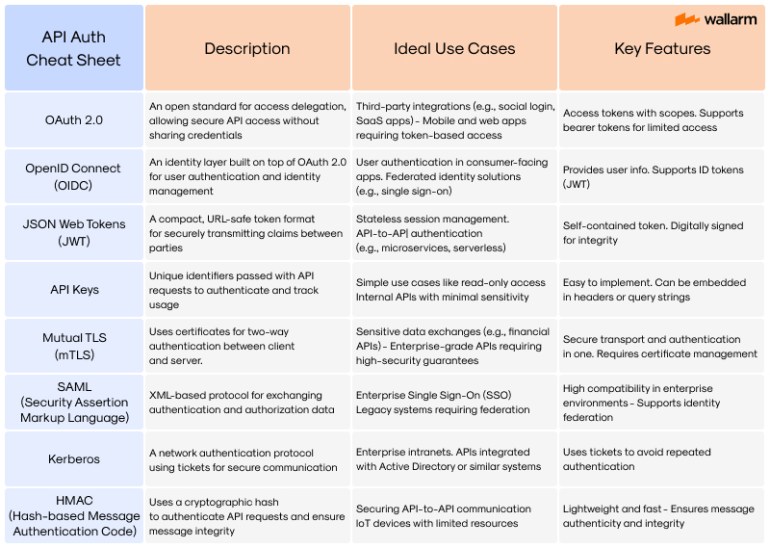
Implementing API authentication is one of the most critical stages of API design and development 2025-1-20 07:7:14 Author: securityboulevard.com(查看原文) 阅读量:1 收藏
Implementing API authentication is one of the most critical stages of API design and development. Properly implemented authentication protects data, user privacy, and other resources while streamlining compliance, preventing fraud, and establishing accountability. In fact, broken authentication is one of the leading causes of API-related breaches.
Ultimately, by applying robust authentication mechanisms, organizations can dramatically improve their API security and reliability. However, choosing the right authentication mechanism can be daunting. In this article, we provide a broad overview of two of the most popular API authentication methods – JWT and OAuth – to help you decide which is right for your organization – so keep reading to find out more.
JSON Web Tokens (JWT): The Lightweight Approach
JSON Web Tokens (JWTs) are a compact, self-contained way to securely transmit information between parties as JSON objects. Primarily used for stateless applications, API authentication, and secure information exchange, they consist of three key components:
- Header: Contains metadata about the token, such as the algorithm used to sign it.
- Payload: Carries the claims, which can include user information, permissions, and expiration time.
- Signature: Ensures the integrity and authenticity of the token.
Why Use JSON Web Tokens?
JWTs are stateless because they encapsulate all necessary information for authentication and authorization within the token itself. This design eliminates the need for servers to maintain session data or user information between requests. This trait makes JWTs ideal for distributed systems. They are also compact, meaning they’re easy to transmit over networks, and their payload can be customized to scale with the API. As with any robust authentication mechanism, they provide a secure way to transmit server information.
How Are JSON Web Tokens Limited?
However, it’s important to recognize that JWTs also have two key drawbacks:
- Revocation Issues: Once issued, a JWT remains valid until its expiration time. Revoking a JWT can be challenging. To overcome this issue, organizations should issue JWTs with short expiration times, maintain lists of revoked JWTs, and create a JSON Web Token Revocation Inventory (JWRI).
- Security Concerns: JWTs don’t come encrypted or signed. Make sure you always sign JWTs with a secret key or use a public/key pair to ensure their integrity, and encrypt payloads for sensitive data to mitigate the risk of data exposure.
OAuth: A Flexible Framework for Authorization
OAuth (and its most recent iteration, OAuth 2.0) is an authorization framework that focuses on enabling third-party applications (clients) to access specific resources belonging to a user on a resource server (like a social media platform or an API) without requiring the user to share their credentials directly with the client, instead using tokens. Common use cases include:
- Social Login: Allowing users to log in to a website or app using their existing credentials from a social media provider (e.g., Google, Facebook).
- Third-Party Applications: Enabling applications to access user data on platforms like Google Drive, Dropbox, or Spotify with user consent.
- API Access: Controlling access to APIs by requiring client applications to obtain authorization from the resource server.
Why Use OAuth?
OAuth 2.0 is a particularly secure API authentication method because, as noted, it doesn’t require users to share passwords directly with third-party applications, thereby reducing the risk of credential exposure. It also includes built-in security measures like token expiration and revocation to reduce the risk of breaches resulting from invalidated tokens.
Granular access control is another reason OAuth 2.0 is so popular. Its scope mechanism grants API providers precise control over what resources third-party applications can access; again, this reduces the risk of data exposure as only the necessary data is shared. Similarly, OAuth offers delegated access, allowing users to grant limited access to their resources while maintaining control over their data.
How Is OAuth Limited?
However, OAuth won’t be right for everyone and does have a couple of key drawbacks, namely because of its statefulness and complexity:
- Statefulness: Some grant types, particularly the authorization code grant, require maintaining a session state on the server; this can add overhead and increase the complexity of the implementation.
- Complexity: OAuth 2.0 implementation can be complex due to its multi-step process involving authorization, token, and resource requests, the variety of grant types, and the need for careful security considerations, including proper token handling, secure communication, and protection against common attacks.
- Security Concerns: Implementing OAuth 2.0 requires careful consideration of several security concerns to ensure the protection of user data and system integrity. Key security concerns include insecure token storage, the exploitation of poorly validated redirect URIs to redirect users to malicious sites, facilitating phishing attacks or unauthorized access, Cross-Site Request Forgery (CSRF) attacks, and insufficient scope validation.
Which Approach is Right For You?
Ultimately, JWT and OAuth are both robust API authentication mechanisms with different strengths and weaknesses. JWT is best used when building stateless, scalable APIs and for organizations that require lightweight, self-contained tokens for authentication. OAuth, however, is best suited for API providers that need to grant third-party applications controlled access to user resources and implement scenarios that involve user consent and delegated access.
That said, you don’t need to decide on one or the other: JWT and OAuth work together and can even complement each other. This is how they can work together:
- Authorization Process: When a client application needs access to a user’s protected resources, it initiates an OAuth 2.0 flow. The user authenticates and grants permission through the authorization server.
- Token Issuance: Upon successful authorization, the authorization server issues an access token to the client. This access token is frequently formatted as a JWT, encapsulating claims about the user’s identity and permissions.
- Accessing Resources: The client includes this JWT access token in the Authorization header of subsequent API requests to the resource server. The resource server validates the token’s signature and claims to ensure the request is authenticated and authorized.
Integrating JWTs with OAuth 2.0 leverages the strengths of both technologies, providing a robust solution for API authentication and authorization. This combination facilitates secure, efficient, and scalable access control in modern web applications.
Depending on your use case, you may want to consider other API authentication methods besides JWTs or OAuth 2.0. The following table provides a quick overview of all the available options, their ideal use cases, and their features.

Secure Your APIs With Wallarm
Robust authentication can help protect APIs, but it can’t do everything. You need a unified API Security and WAAP (Web App and API Protection) platform to protect your entire API and web application portfolio. Wallarm provides just that. Book a demo today to see what it can do.
The post Considerations for Selecting the Best API Authentication Option appeared first on Wallarm.
*** This is a Security Bloggers Network syndicated blog from Wallarm authored by Ivan Novikov. Read the original post at: https://lab.wallarm.com/considerations-selecting-best-api-authentication-option/
如有侵权请联系:admin#unsafe.sh

